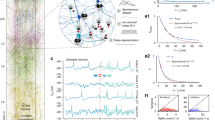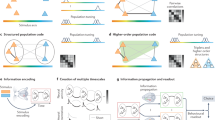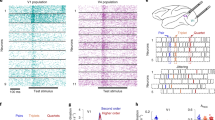Abstract
Populations of neurons in the retina1,2,3, olfactory system4, visual5 and somatosensory6 thalamus, and several cortical regions7,8,9,10 show temporal correlation between the discharge times of their action potentials (spike trains). Correlated firing has been linked to stimulus encoding9, attention11, stimulus discrimination4, and motor behaviour12. Nevertheless, the mechanisms underlying correlated spiking are poorly understood2,3,13,14,15,16,17,18,19,20, and its coding implications are still debated13,16,21,22. It is not clear, for instance, whether correlations between the discharges of two neurons are determined solely by the correlation between their afferent currents, or whether they also depend on the mean and variance of the input. We addressed this question by computing the spike train correlation coefficient of unconnected pairs of in vitro cortical neurons receiving correlated inputs. Notably, even when the input correlation remained fixed, the spike train output correlation increased with the firing rate, but was largely independent of spike train variability. With a combination of analytical techniques and numerical simulations using ‘integrate-and-fire’ neuron models we show that this relationship between output correlation and firing rate is robust to input heterogeneities. Finally, this overlooked relationship is replicated by a standard threshold-linear model, demonstrating the universality of the result. This connection between the rate and correlation of spiking activity links two fundamental features of the neural code.
This is a preview of subscription content, access via your institution
Access options
Subscribe to this journal
Receive 51 print issues and online access
$199.00 per year
only $3.90 per issue
Buy this article
- Purchase on Springer Link
- Instant access to full article PDF
Prices may be subject to local taxes which are calculated during checkout




Similar content being viewed by others
References
Mastronarde, D. N. Correlated firing of cat retinal ganglion cells. I. spontaneously active inputs to x-and y-cells. J. Neurophysiol. 49, 303–324 (1983)
Schneidman, E., Berry, M. J., Segev, R. & Bialek, W. Weak pairwise correlations imply strongly correlated network states in a neural population. Nature 440, 1007–1012 (2006)
Shlens, J. et al. The structure of multi-neuron firing patterns in primate retina. J. Neurosci. 26, 8254–8266 (2006)
Stopfer, M., Bhagavan, S., Smith, B. H. & Laurent, G. Impaired odour discrimination on desynchronization of odour-encoding neural assemblies. Nature 390, 70–74 (1997)
Alonso, J. M., Usrey, W. M. & Reid, W. M. Precisely correlated firing in cells of the lateral geniculate nucleus. Nature 383, 815–819 (1996)
Bruno, R. M. & Sakmann, B. Cortex is driven by weak but synchronously active thalamocortical synapses. Science 312, 1622–1627 (2006)
Zohary, E., Shadlen, M. N. & Newsome, W. T. Correlated neuronal discharge rate and its implication for psychophysical performance. Nature 370, 140–143 (1994)
Kohn, A. & Smith, M. A. Stimulus dependence of neuronal correlation in primary visual cortex of the macaque. J. Neurosci. 25, 3661–3673 (2005)
deCharms, R. C. & Merzenich, M. M. Primary cortical representation of sounds by the coordination of action potentials. Nature 381, 610–613 (1996)
Bair, W., Zohary, E. & Newsome, W. T. Correlated firing in macaque visual area MT: Time scales and relationship to behavior. J. Neurosci. 21, 1676–1697 (2001)
Steinmetz, P. N. et al. Attention modulates synchronized neuronal firing in primate somatosensory cortex. Nature 404, 187–190 (2000)
Vaadia, E. et al. Dynamics of neuronal interactions in monkey cortex in relation to behavioural events. Nature 373, 515–518 (1995)
Abeles, M. Corticonics: Neural circuits of the cerebral cortex (Cambridge Univ. Press, New York, 1991)
Svirskis, G. & Hounsgaard, J. Influence of membrane properties on spike synchronization in neurons: theory and experiments. Network Comput. Neural Syst. 14, 747–763 (2003)
Galán, R. F., Fourcaud-Trocme, N., Ermentrout, G. B. & Urban, N. N. Correlation-induced synchronization of oscillations in olfactory bulb neurons. J. Neurosci. 26, 3646–3655 (2006)
Shadlen, M. N. & Newsome, W. T. The variable discharge of cortical neurons: implications for connectivity, computation, and information coding. J. Neurosci. 18, 3870–3896 (1998)
Binder, M. D. & Powers, R. K. Relationship between simulated common synaptic input and discharge synchrony in cat spinal motoneurons. J. Neurophysiol. 86, 2266–2275 (2001)
Dorn, J. D. & Ringach, D. L. Estimating membrane voltage correlations from extracellular spike trains. J. Neurophysiol. 89, 2271–2278 (2003)
Reyes, A. D. Synchrony-dependent propagation of firing rate in iteratively constructed networks in vitro. Nature Neurosci. 6, 593–599 (2003)
Doiron, B., Rinzel, J. & Reyes, A. Stochastic synchronization in finite size spiking networks. Phys. Rev. E 74, 030903 (2006)
Averbeck, B. B., Latham, P. E. & Pouget, A. Neural correlations, population coding and computation. Nature Rev. Neurosci. 7, 358–366 (2006)
Salinas, E. & Sejnowski, T. J. Correlated neuronal activity and the flow of neural information. Nature Rev. Neurosci. 2, 539–550 (2001)
Destexhe, A., Rudolph, M. & Paré, D. The high-conductance state of neocortical neurons in vivo. Nature Rev. Neurosci. 4, 739–751 (2003)
Lampl, I., Reichova, I. & Ferster, D. Synchronous membrane potential fluctuations in neurons of the cat visual cortex. Neuron 22, 361–374 (1999)
Ricciardi, L. M. Diffusion Processes and Related Topics in Biology (Springer, Berlin, 1977)
Lindner, B., Doiron, B. & Longtin, A. Theory of oscillatory firing induced by spatially correlated noise and delayed inhibitory feedback. Phys. Rev. E 72, 061919 (2005)
Lau, D. et al. Impaired fast-spiking, suppressed cortical inhibition, and increased susceptibility to seizures in mice lacking kv3.2 K+ channel proteins. J. Neurosci. 20, 9071–9085 (2000)
Tsodyks, M. V. & Markram, H. The neural code between neocortical pyramidal neurons depends on neurotransmitter release probability. Proc. Natl Acad. Sci. USA 94, 719–723 (1997)
Polsky, A., Mel, B. & Schiller, J. Computational subunits in thin dendrites of pyramidal cells. Nature Neurosci. 7, 621–627 (2004)
Larkum, M. E., Senn, W. & Lüscher, H.-R. Top-down dendritic input increases the gain of layer 5 pyramidal neurons. Cereb. Cortex 14, 1059–1070 (2004)
Acknowledgements
We thank C. Colbert, A. Kohn, L. Maler, D. Nikolic, A.-M. Oswald and A. Renart for their critical reading of the manuscript, and R. Moreno-Bote, M. Schiff and J. Rinzel for insightful discussions. Funding was provided by the Spanish MEC (J.R.), HFSP (B.D.), a Burroughs Welcome Fund career award and an NSF postdoctoral fellowship (E.S.-B.), NSF (K.J.) and NIH (A.R.).
Author information
Authors and Affiliations
Corresponding authors
Ethics declarations
Competing interests
Reprints and permissions information is available at www.nature.com/reprints. The authors declare no competing financial interests.
Supplementary information
Supplementary Information
This file contains Supplementary Methods, Supplementary Figures S1-S6 with Legends illustrating additional analysis of the correlation-rate relation and a complete derivation of Eq. (3) presented in the main text. (PDF 1362 kb)
Rights and permissions
About this article
Cite this article
de la Rocha, J., Doiron, B., Shea-Brown, E. et al. Correlation between neural spike trains increases with firing rate. Nature 448, 802–806 (2007). https://doi.org/10.1038/nature06028
Received:
Accepted:
Published:
Issue Date:
DOI: https://doi.org/10.1038/nature06028
This article is cited by
-
Endogenous cannabinoids in the piriform cortex tune olfactory perception
Nature Communications (2024)
-
Heterogeneity of voltage gated sodium current density between neurons decorrelates spiking and suppresses network synchronization in Scn1b null mouse models
Scientific Reports (2023)
-
Propagation of activity through the cortical hierarchy and perception are determined by neural variability
Nature Neuroscience (2023)
-
Astrocytic Gap Junctions Contribute to Aberrant Neuronal Synchronization in a Mouse Model of MeCP2 Duplication Syndrome
Neuroscience Bulletin (2022)
-
Analytic Investigation for Synchronous Firing Patterns Propagation in Spiking Neural Networks
Neural Processing Letters (2022)
Comments
By submitting a comment you agree to abide by our Terms and Community Guidelines. If you find something abusive or that does not comply with our terms or guidelines please flag it as inappropriate.



